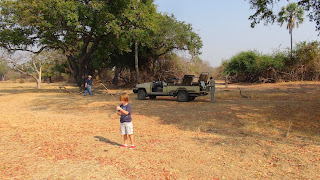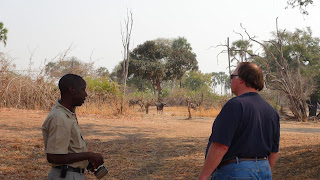In the previous post, I wrote about the house we stayed in and shared some pictures of many of the animals we saw. Here are even more pictures from our week in South Luangwa.
We had some fantastic views of wildlife from our house. The elephants would often go for a swim in the heat of the day, which was a lot of fun to watch. You can see some elephants taking a dip in the video at the bottom of this post.
That night the staff had a surprise for us: they'd planned a sundowner for us in the bush! It was a lot of fun.
Carter was pretending to be a rock hyrax here, I think.
The elephants then went on to the water hole to have a drink.
One evening we saw a wobbly little newborn puku trying to keep up with its mother. It was so tiny and adorable! We saw it again the next morning, and we were happy to know it had made it through its first night. (See it in - you guessed it - the video below.)
I edited together the best bits of video we captured into one piece. It's about 20 minutes long, but it features lions, leopards (including cubs), hyenas, elephants (some swimming!), hippos, and even mating giraffes. Enjoy!
Where there is water, there are birds. This is a saddle-billed stork.
This hippo might look dead, but he's fine. When male hippos get older, the younger males kick them out of the pod, and they tend to go off and find places to hang out in alone. This mud hole is drying up, so this guy will have to find another spot soon.
Here are a few more lone male hippos.
This is a male puku.
Winter is the dry season in much of southern Africa, so the landscape looks barren and brown. This forces the animals to congregate around water sources, though, so it's the best time to visit. We've heard that you can come here in the summer time and barely see an elephant for all the vegetation.
This is a morning tea break, I believe. Carter loved running around on the ground and exploring.
Note the cape buffalo in the background of this shot of Doug talking with our Guide, Obi. The herd was heading to the nearby water hole, and stopped to stare at us for a while.
We had some fantastic views of wildlife from our house. The elephants would often go for a swim in the heat of the day, which was a lot of fun to watch. You can see some elephants taking a dip in the video at the bottom of this post.
Wild dogs are rare to see in this area, so we considered ourselves very lucky to see them. We followed them when they started hunting, and then our spotter John saw a leopard watching from a tree!
It's incredible to see more than one kind of carnivore on a drive, but to see two at the same time is something I've never done before. We didn't know which way to look!
The leopard eventually came down for a drink.
And then I was able to get this picture in which you can see both the leopard and the dogs! Amazing!
That night the staff had a surprise for us: they'd planned a sundowner for us in the bush! It was a lot of fun.
Carter was pretending to be a rock hyrax here, I think.
On the way back to the house that night, we saw a porcupine - very rare, in our experience.
This photo shows how truly massive the termite mounds can be. For reference, the antelopes standing at the base are about the size of a small deer.
Morning tea stop under a Baobab tree.
We saw so many leopards during the week. A highlight was seeing these two leopard cubs. Obi said they were around three months old. You can also see them in the video at the bottom of this post.
This leopard is the older brother of those two cubs. He's around two years old, and Obi said he will still occasionally share a kill with his mother and little sisters.
He was very relaxed around us, but when a herd of elephants walked by, he flattened himself to the ground to hide. One of the young males saw him and started towards him, and he ran into the bushes. (You can see this in the video below.)
The elephants then went on to the water hole to have a drink.
Zebras are so beautiful.
Carter liked "rover surfing" when the roads got extra bumpy.
We got a flat tire one morning, and Carter was fascinated while watching Obi change the tire. I don't think he's ever seen anyone change a tire before, amazingly enough!
On our last full day, we got another surprise -- a brunch in the bush! The staff had set up a fire to cook on and everything. It was really nice to sit and eat our bacon and eggs, and watch zebras heading down to the water hole.
Carter enjoyed hanging out with the park ranger who was there to make sure we were safe.
Amy made sure we had everything we needed for a fantastic brunch.
The zebras were a little uncertain about us, but eventually decided to go the long way around.
As usual, Carter found a good stick to play with.
On our last game drive, we saw the young male leopard one more time. He's in the tree below. Can you spot him?
It's amazing how well-disguised these animals are.
And they're so, so beautiful.
On our very last morning, we invited our hostess Amy to come along with us on the game drive. She had been a fantastic host all week, and Carter adored her. She spent a lot of time looking at his drawings and talking with him, and they even wrote each other notes every day. He was very excited to have her sitting next to him in the game drive vehicle that morning!
We had a very interesting last game drive. We saw a herd of buffalo.
We also found some giraffes in the process of mating. (You can also see this in the video below -- it happens very quickly.)
The most exciting part of the morning, though, was when we spotted a pair of lions not far from camp. There was another vehicle on the sighting as well, and one of the guides quickly noticed that one of the lions had a snare around her neck. Snare hunting is illegal in the vicinity of the park because the snares don't only catch the antelope the hunters are aiming for. They will also get caught on elephants' trunks and on the legs of dogs and cats, and the resulting injuries often cause the animals to be unable to survive.
This lion had caught her head in the snare and she was apparently able to escape, but it embedded itself in the skin around her neck. She was panting, visibly struggling to breathe. The guides called the park officials immediately, who came to assess the situation. They don't intervene when animals' injuries are the result of natural causes, but when the injuries are the result of human action, they will step in to do what they can. In this case, they brought in a team of veterinarians and researchers. The lion was first darted with a tranquilizer gun, and once she'd passed out, the team moved in to remove the snare from her neck and give her a check-up. The researchers took blood samples and measurements, and the vet injected her with an antibiotic before they got back in their vehicles and moved a distance away to wait until she woke up. (You can see some of this in the video.)
After a wonderful week in Robin Pope's house in South Luangwa, it was time to move on. We said goodbye to our fantastic guide Obi and to Amy.
This is one place we definitely plan to return to one day. It was one of the best safari experiences we've ever had -- and that's actually saying something.
I edited together the best bits of video we captured into one piece. It's about 20 minutes long, but it features lions, leopards (including cubs), hyenas, elephants (some swimming!), hippos, and even mating giraffes. Enjoy!































































No comments:
Post a Comment